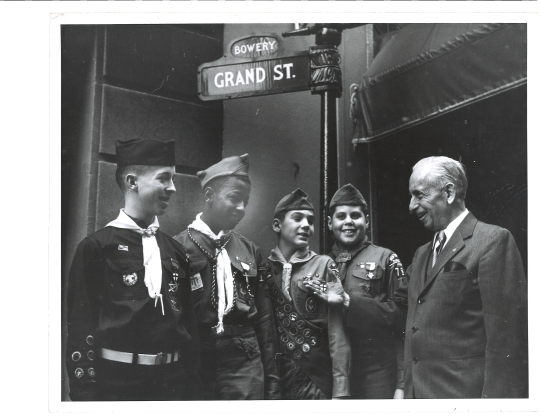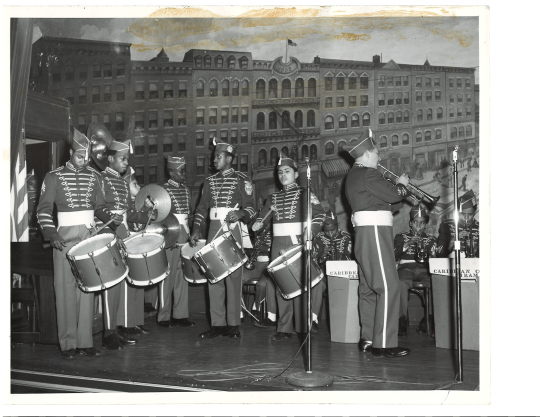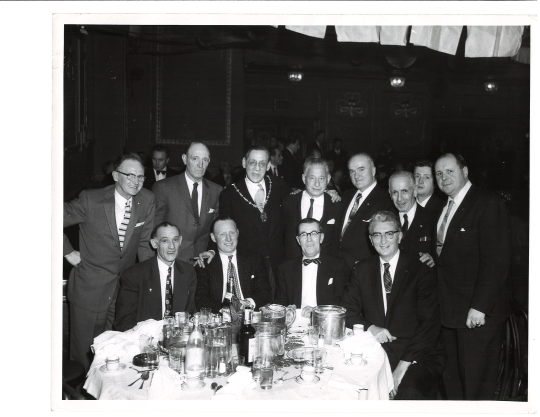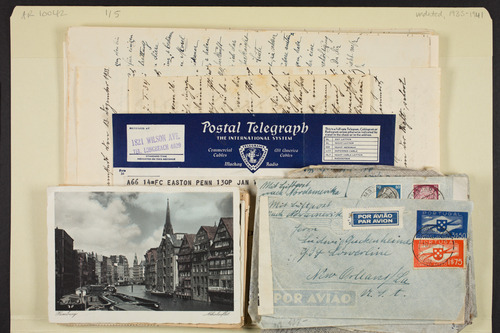By Patricia Glowinski, Archivist at the Center for Jewish History
Processed in the Shelby White & Leon
Levy Archival Processing Laboratory at the Center for Jewish History (CJH) are
the Grand Street Boy’s Association Records, just one of the many archival collections
of the American Jewish Historical Society, one of the five partner institutions
comprising CJH. The collection documents 20th century American
Jewish history and New York City history, as they intersect in the activities of
the once thriving club whose motto was “Good Fellowship,
Benevolence, Charity.”
The origins
of the Grand Street Boys’ Association date back to 1916 when a reunion was held in Manhattan for men who had grown up
on or near bustling Grand Street, a main thoroughfare in the Lower East Side. Grand
Street in the early 1900s was the center of a large immigrant neighborhood and
was home to many Eastern European (many of them Jewish), Italian, and Irish
immigrants. The success of that 1916 reunion led to a second reunion in 1920
where it was decided that a permanent club should be formed. The Grand Street
Boys’ Association was incorporated in 1921 and they opened their first clubhouse
in 1924 in the former MacDougal Club, located at 106-108 West 55th Street in
Midtown Manhattan. The clubhouse had a gym, lounge, dining room, barbershop, library,
and an auditorium.
Mirroring
the demographic makeup of the Lower East Side in the early 1900s, original
members were primarily Jewish, but were also Irish and Italian, among other
ethnicities. Open to all men (and eventually women) regardless of religion,
ethnicity, or social class, the Grand Street Boys promoted welfare projects,
acts of fellowship and tolerance, scholarships, youth employment, war efforts,
and the elimination of discrimination in sports, among other projects. At
first, only men who grew in the vicinity of Grand Street were eligible to
enroll. This restriction was soon removed and the Association became the
“headquarters of those who really love New York.”
As
documented in the extensive membership records from the collection (See Series
1, Subseries 4), membership spanned all sectors of social class and occupations.
Alongside governors, mayors, judges, senators, and famous entertainers were
bartenders, furriers, detectives, opera singers, restaurateurs, art therapists,
umbrella salesmen, meter readers, and firemen. Well-known members included
Irving Berlin, Eddie Cantor, Irving Caesar, Fiorello La Guardia, Al Smith, John
Lindsay, Robert F. Wagner Jr., Jonah J. Goldstein, Herbert H. Lehman, Nelson A.
Rockefeller, and Cardinal Patrick Hayes.
The collection documents the activities of the
Association, as well as the Grand Street Boys’ Foundation, its financial arm
established in 1945, and its Hobbycraft Program, a charitable program tasked
with collecting and redistributing donated items to charitable and nonprofit
organizations. Materials include administrative records, financial records,
correspondence, minutes, membership records, newsletters, yearbooks, artifacts,
and photographs. The collection’s strengths include the membership records, the
meeting minutes, the Grand Street Boys’ publications including the newsletter, Wuxtra, and the yearbooks, and the
photographs which capture the spirit and essence of the Grand Street Boys’
Association during its prime. Below are just a few photos that will (hopefully)
inspire researchers to come to the Lillian Goldman Reading Room and use the
collection!

1. Boy
Scouts with Jonah J. Goldstein, President of the Grand Street Boys’ Association,
at the Grand Street Boys’ clubhouse, circa 1960 (Photo credit: New York Times)

2. Irving Caesar
(third from left), songwriter and Grand Street Boy, at Colony Records in
Manhattan for the publication of the Grand Street Boys’ song, 1960

3. Golden
wedding party at the clubhouse showing Mr. and Mrs. Frank Hershkowitz dancing
to Jack Snyder’s accordion music, 1959 (Photo credit: Daily News)

4.
Jonah J. Goldstein presenting a Grand Street Boys’ Association award to Mickey
Mantle, 1953

5. Grand
Street House London showing Sir Louis Sterling (former Lower East Sider and
life member of the Grand Street Boys), 1941 (Photo credit: Sport & General
Press Agency, London)

6. Gramercy
Boys Club, known for its marching band, performing in the auditorium at the
clubhouse, circa 1960

7. Robert
Briscoe (standing, 3rd from left), who became the first Jewish Lord
Mayor of Dublin in 1956, at a dinner at the Grand Street Boys’ clubhouse, with
Abe Stark (standing, 4th from left), Jonah J. Goldstein (standing, 3rd from right), and others, circa 1957


